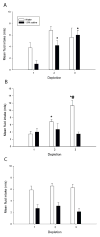Dissociation of thirst and sodium appetite in the furo/cap model of extracellular dehydration and a role for N-methyl-D-aspartate receptors in the sensitization of sodium appetite
- PMID: 24341713
- PMCID: PMC4433317
- DOI: 10.1037/a0034948
Dissociation of thirst and sodium appetite in the furo/cap model of extracellular dehydration and a role for N-methyl-D-aspartate receptors in the sensitization of sodium appetite
Abstract
Depletion of extracellular fluids motivates many animals to seek out and ingest water and sodium. Animals with a history of extracellular dehydration display enhanced sodium appetite and, in some cases, thirst. The progressive increase in sodium intake induced by repeated sodium depletions is known as sensitization of sodium appetite. Administration of the diuretic and natriuretic drug, furosemide, along with a low dose of captopril (furo/cap), elicits thirst and a rapid onset of sodium appetite. In the present studies the furo/cap model was used to explore the physiological mechanisms of sensitization of sodium appetite. However, when thirst and sodium appetite were measured concurrently in the furo/cap model, individual rats exhibited sensitization of either thirst or sodium appetite. In subsequent studies, thirst and sodium appetite were dissociated by offering either water prior to sodium or sodium before water. When water and sodium intake were dissociated in time, the furo/cap model reliably produced sensitization of sodium appetite. It is likely that neuroplasticity mediates this sensitization. Glutamatergic N-methyl-d-aspartate receptor (NMDA-R) activation is critical for the development of most forms of neuroplasticity. Therefore, we hypothesized that integrity of NMDA-R function is necessary for the sensitization of sodium appetite. Pharmacological blockade of NMDA-Rs with systemic administration of MK-801 (0.15 mg/kg) prevented the sensitization of fluid intake in general when water and sodium were offered concurrently, and prevented sensitization of sodium intake specifically when water and sodium intake were dissociated. The involvement of NMDA-Rs provides support for the possibility that sensitization of sodium appetite is mediated by neuroplasticity.
Figures








References
-
- Appel LJ, Frohlich ED, Hall JE, Pearson TA, Sacco RL, Seals DR, Sacks FM, Smith SC, Jr, Vafiadis DK, Van Horn LV. The importance of population-wide sodium reduction as a means to prevent cardiovascular disease and stroke: A call to action from the american heart association. Circulation. 2011;123(10):1138–1143. - PubMed
-
- Bare JK. The specific hunger for sodium chloride in normal and adrenalectomized white rats. Journal of Comparative and Physiological Psychology. 1949;42(4):242. - PubMed
-
- Berridge KC, Flynn FW, Schulkin J, Grill HJ. Sodium depletion enhances salt palatability in rats. Behavioral Neuroscience. 1984;98(4):652–660. - PubMed
-
- Brown IJ, Tzoulaki I, Candeias V, Elliott P. Salt intakes around the world: Implications for public health. International Journal of Epidemiology. 2009;38(3):791–813. - PubMed
Publication types
MeSH terms
Substances
Grants and funding
LinkOut - more resources
Full Text Sources
Other Literature Sources
Medical
Miscellaneous

